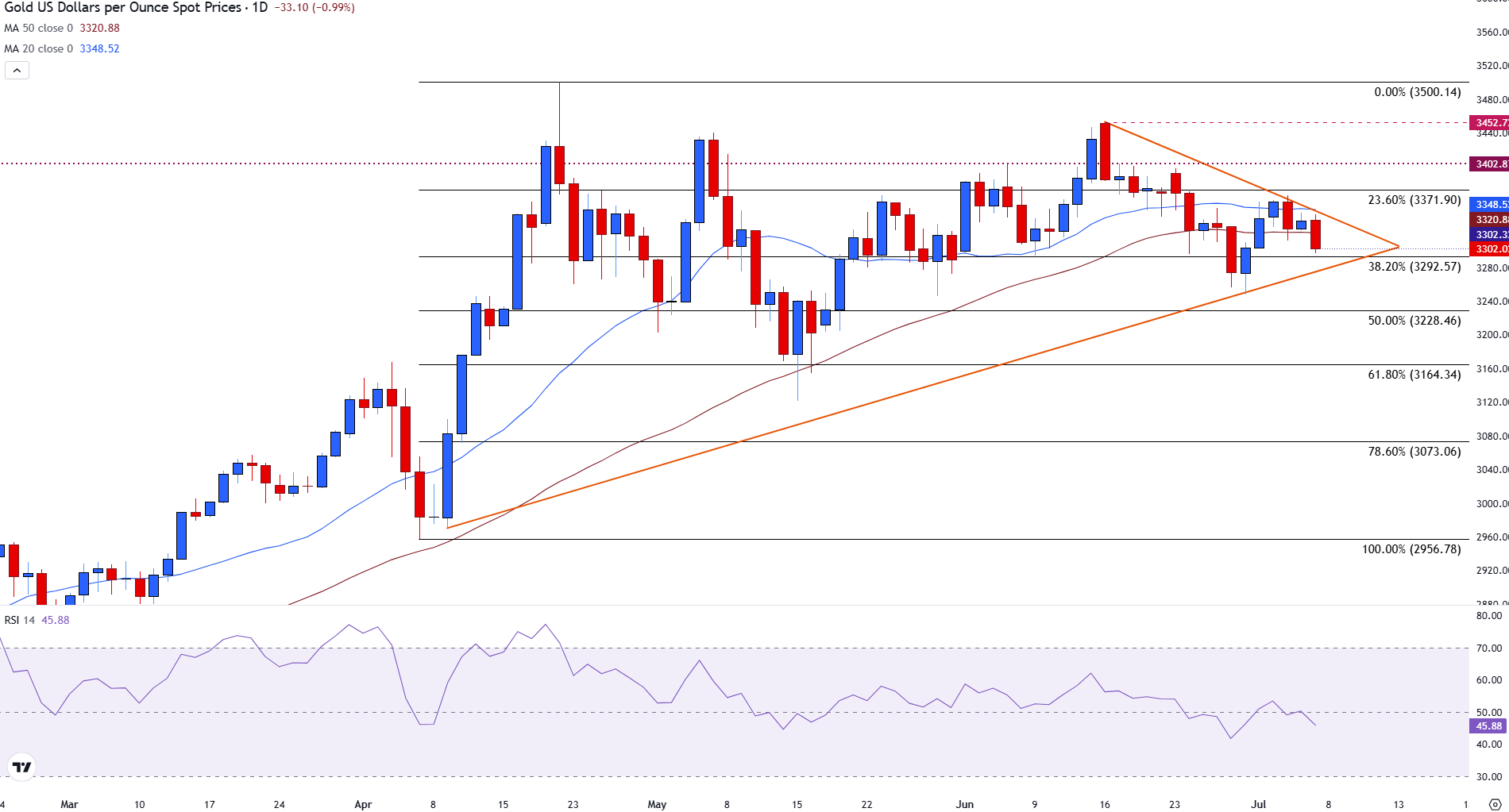Gold slips as the US Dollar gains on hawkish Fed and trade optimism
- Gold price weakens amid a rising US Dollar and hopes of trade deals.
- Trump's tariff threats to countries aligning with “Anti-American BRICS policies” can limit downside for Gold.
- XAU/USD heads for the triangle support, dropping to $3,300.
Gold (XAU/USD) is currently under pressure as markets await more news of trade deals ahead of Wednesday’s tariff deadline.
In the European session, Gold is trading around $3,300 at the time of writing.
Liquidity and trade volumes are increasing on Monday as the US returns to financial markets following Friday’s Independence Day holiday.
US yields have also firmed after Thursday’s Nonfarm Payrolls (NFP) report revealed a resilient labour market. This reduced the prospects that the Federal Reserve (Fed) would lower interest rates in July. The positive economic data has eased fears of a slowing economy, lifting the US Dollar.
Expectations that interest rates will remain at higher levels for longer do not bode well for non-yielding assets such as bullion.
Daily digest market movers: Gold awaits details on trade deals, FOMC Minutes
- Reporters spoke to US President Donald Trump at the Morristown Airport on Sunday about the trade negotiations. "I think we will have most countries done by July 9, either a letter or a deal,” he said.
- Letters outlining the tariffs that will be charged to 12-15 countries are expected to be sent by noon on Monday. The remaining notifications are to be dispatched before Wednesday. Reciprocal tariffs are set to take effect starting August 1.
- Trump has written a post on Truth Social stating that “Any country aligning themselves with the Anti‑American policies of BRICS, will be charged an ADDITIONAL 10 % tariff. There will be no exceptions to this policy.”
- The BRICS summit in Rio de Janeiro is currently underway, and the emerging market nations that established the bloc are beginning to reduce their reliance on the United States. This initiative includes moving away from using the US Dollar as a receiving currency, a concept known as de-dollarization.
- BRICS is an acronym that stands for an association of five major emerging economies: Brazil, Russia, India, China, and South Africa. This group was formed to enhance economic cooperation and promote development in these countries. BRICS nations collaborate on various issues, including trade, investment, finance, and sustainable development. They aim to increase their influence in global economic and political affairs. The bloc also holds annual summits to discuss and coordinate strategies for mutual support and growth.
- The World Gold Survey in June showed that demand for bullion has been on the rise, especially with tensions between the US and China escalating in recent years.
- The Federal Open Market Committee will release the Minutes from its June Meeting on Wednesday. This report outlines the reasons for maintaining interest rates at the current range of 4.25% to 4.50% in June. It also provides insight into the perspective of the Board of Governors members regarding the prospects of the US economy. This influences expectations of when the Fed may cut interest rates.
Gold technical analysis: XAU/USD heads for the triangle support
The current daily chart of Gold shows price action consolidating within a symmetrical triangle, suggesting that a breakout is likely as the range narrows. This tightening formation reflects growing pressure, which often precedes a significant directional move.
Recently, XAU/USD dropped below both the 20-day Simple Moving Average at $3,348 and the 50-day SMA at $3,320. The price is also approaching the 38.2% Fibonacci retracement level at $3,292, a critical support zone that will help determine the near-term direction.
If the latter fails, downside targets include the 50% and 61.8% Fibonacci retracement levels at $3,228 and $3,164, respectively.
Spot Gold (XAU/USD) daily chart

However, if the price manages to hold above $3,300 and rebound, a bullish reversal could occur. In that case, the first upside targets would be reclaiming the 50-day SMA and then the 20-day SMA. A confirmed breakout above the triangle resistance and the 23.6% Fibonacci level at $3,371 would open the door for further gains, with a potential move toward psychological resistance at $3,400.
The Relative Strength Index (RSI) sits near 45, reflecting mild bearish momentum but with room enough before going into oversold territory.
Gold FAQs
Gold has played a key role in human’s history as it has been widely used as a store of value and medium of exchange. Currently, apart from its shine and usage for jewelry, the precious metal is widely seen as a safe-haven asset, meaning that it is considered a good investment during turbulent times. Gold is also widely seen as a hedge against inflation and against depreciating currencies as it doesn’t rely on any specific issuer or government.
Central banks are the biggest Gold holders. In their aim to support their currencies in turbulent times, central banks tend to diversify their reserves and buy Gold to improve the perceived strength of the economy and the currency. High Gold reserves can be a source of trust for a country’s solvency. Central banks added 1,136 tonnes of Gold worth around $70 billion to their reserves in 2022, according to data from the World Gold Council. This is the highest yearly purchase since records began. Central banks from emerging economies such as China, India and Turkey are quickly increasing their Gold reserves.
Gold has an inverse correlation with the US Dollar and US Treasuries, which are both major reserve and safe-haven assets. When the Dollar depreciates, Gold tends to rise, enabling investors and central banks to diversify their assets in turbulent times. Gold is also inversely correlated with risk assets. A rally in the stock market tends to weaken Gold price, while sell-offs in riskier markets tend to favor the precious metal.
The price can move due to a wide range of factors. Geopolitical instability or fears of a deep recession can quickly make Gold price escalate due to its safe-haven status. As a yield-less asset, Gold tends to rise with lower interest rates, while higher cost of money usually weighs down on the yellow metal. Still, most moves depend on how the US Dollar (USD) behaves as the asset is priced in dollars (XAU/USD). A strong Dollar tends to keep the price of Gold controlled, whereas a weaker Dollar is likely to push Gold prices up.

